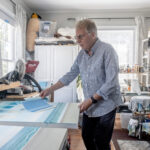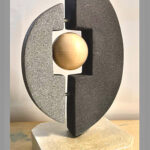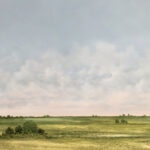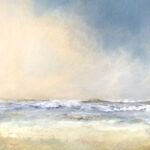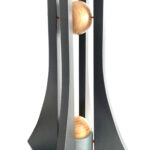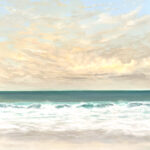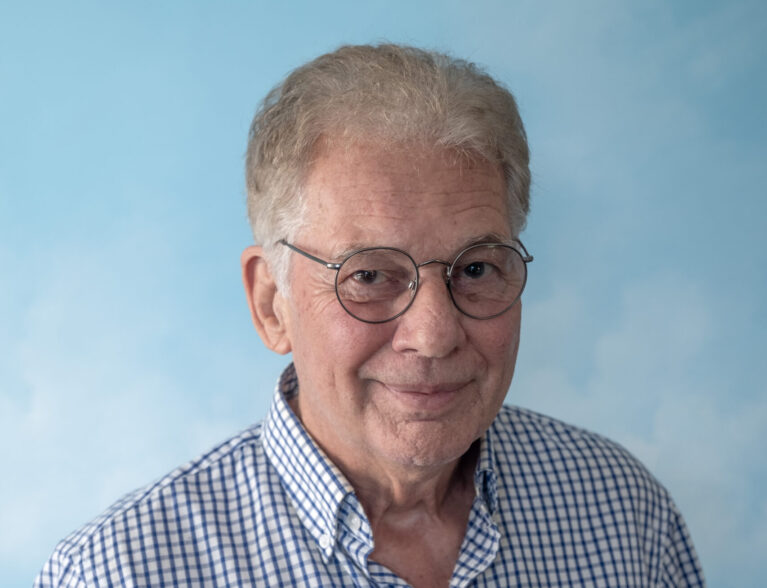
Sailing solo by sailboat from Boston to Stuart, Peter Laughton says he had a lot of time to contemplate the course of his life, after leaving a corporate job as a trade show designer behind. After spending eight weeks at sea, covering 2,000 miles, he emerged with a whole new perspective on life and of our human frailty.
“Being alone in my thoughts and at the mercy of the wind and restless seas, I felt a strange detachment from society and a new appreciation to the land we belong to,” says Laughton.
“Seeing the land from the water’s perspective is very different, and drifting slowly under sail beneath an intense canopy of bright stars is intoxicating. By the time I arrived in Stuart I knew my life would take a different direction.”
To pass the hours while he was on board, Laughton began painting small watercolor seascapes, the sort suitable for notes or postcards. With nothing but the sea, clouds and the distant horizon as inspiration, he perfected the ability to capture the vastness of the ocean and the never-ending dance of clouds against the sky.
Laughton says he was mesmerized by the complex interactions between sky, water and land, and through his artwork, strove to capture the fickle ways that light impresses itself on that panorama.
“I never really called myself an artist until I came ashore in Stuart back in 2011,” Laughton says. “I boldly decided to visit some local galleries to see if anyone was interested in showing my paintings. Luckily there one was willing to give me a show and my career as an artist was born.”
Since those early days, when he worked primarily with watercolors, Laughton has experimented with different media approaches. While mixed media allowed him the most flexibility and range of expression, he found that oil painting was his most satisfying means of expression and has focused on that for the past decade.
“My most recent paintings have evolved from a mostly impressionistic style to one that is a bit more abstract,” he explains.
“This difference is achieved largely through unusual textural innovations in otherwise uniform surfaces. Some of my latest work has a three-dimensional element that I achieve by applying layers of different textures to make it more abstract.”
The one thing that hasn’t changed, however, is his subject matter. Laughton’s artwork depicts the vastness of the sky on the horizon where it meets the depths of the ocean, along with the interplay of light in the clouds and the waves breaking at the shoreline. One can’t help but feel small in comparison to the natural phenomena that emerge from the canvas.
“Evocative, suggestive seascapes and landscapes draw people toward my paintings and into a timeless space that silences the chaos around us,” he says.
“I want to solicit an emotional response to images drawn from my imagination, which is incessantly fueled by the world around me.”
Laughton doesn’t use photos or references when he paints. Instead, his artwork begins with an idea, which is committed to paper with a rough sketch. However, rarely does that original sketch transform into a painting that mirrors its image. Instead, it evolves throughout the process.
“I keep a photo record of each painting’s evolution to document its transformation,” he explains.
“Sometimes the painting has changed in interesting ways that reflects something within me that needed to be expressed. It’s a process that originates in my head and grows and changes as the brush meets the canvas.”
Not one to be beholden to a single means of expression, Laughton also creates remarkable sculptures in wood. He began sculpting back in the 1970s, when he would construct freeform sculptures using scrap wood gathered from a furniture design business he owned. His sculpting style mirrored the simple, clean lines of his furniture, which was constructed using teak and leather.
“I love working with my hands and I love working with wood. Most galleries won’t show sculptures, however, because they can’t make enough money on the sale. I, too, realized that I couldn’t make a living off my sculptures, so while I enjoy making them, I don’t do them regularly.”
For the past five years, Laughton has lived and worked out of his corner apartment in the historic Pocahontas building in downtown Vero Beach.
“My friends in Stuart directed me here and I fell in love with the building,” he confides.
“It was in the middle of a renovation, and I had to wait a month before I could move in. I love that I can walk from my bedroom to my studio and paint whenever I have an inspiration, whether it be in the middle of the night or the light of day. The natural light coming in from the windows facing east inspires me to capture that first morning light of day in my seascapes.”
Along with the size of Laughton’s paintings – some as large as 4 feet by 5 feet – his reputation as an artist has also grown, with quite a few of his works gracing the homes of John’s Island and Windsor residents.
Locally his work is represented at the upscale Meghan Candler Gallery in Vero’s Village Shops.
- Peter Laughton PHOTO BY JOSHUA KODIS
- Peter Laughton PHOTO BY JOSHUA KODIS
- PHOTO BY JOSHUA KODIS
- PHOTO BY JOSHUA KODIS
- PHOTO BY JOSHUA KODIS
- PHOTO PROVIDED
- PHOTO PROVIDED
- PHOTO PROVIDED
- PHOTO PROVIDED
- PHOTO PROVIDED
- PHOTO PROVIDED
- PHOTO PROVIDED


